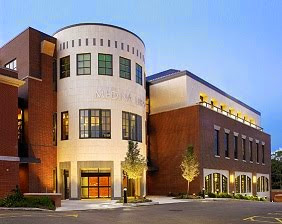 | |
| The Main Branch of the Akron Summit County Public Library |
Any time you can listen to a nationally known genealogy speaker, instructor, and author FOR FREE, you should go for it.
The Akron Summit County Public Library has presented such an event once a year, for the past six years.
This past weekend, they hosted John Philip Colletta, noted genealogist and author of several books, including:
- They Came in Ships: a Guide to Finding Your Immigrant Ancestor's Arrival Record
- Finding Your Italian Roots, a Guide for Americans and most recently
- Only a Few Bones, the True Account of the Rolling Fork Tragedy and Its Aftermath.
 |
| Author John Philip Colletta & Judy James ASCPL |
This all day program was titled Our Ancestors from Europe: How to Discover Their Individual Stories. And it was incredible. He broke his talk into 4 components:
- Passenger Arrival Records, Colonial Times to Mid-20th Century
- Naturalization Records, Colonial Times to Mid-20th Century
- Re-Discovering "La Famiglia;" Accessing and Using the Records of Italy
- Discovering the REAL Stories of Your Immigrant Ancestors
 | |||||
| Program attendees perusing literature provided by the library & Gen. Soc. |
The information on the post-1820 passenger lists and naturalization records should be familiar to anyone doing research for some time. If not, there are plenty of resources in libraries and online to help you with that. I was most interested in the pre-1820 records, as that was when most of my immigrant ancestors made their way to America.
Why the 1820 demarcation? That was the year the U.S. passed a law requiring all ship's captains to turn in a list of passengers arriving from foreign ports. I have not had much success tracking down my pre-1820 immigrants. But John's lecture covered what information is needed to begin the search: the immigrant's full name, approximate year of immigration, and country of origin. Also, he said that era is well researched and many sources have been published that replace the non-existent passenger lists.
For naturalization records, he said you must check all courts of record in the area's where your ancestor lived. Some immigrants chose not to become naturalized citizens. But most did, because it conferred the right to vote and the right to hold office, among other rights. You have to know what the law was at the time your ancestor immigrated. Prior to 1790, the colonies also had laws regarding naturalization. The British Colonies had laws to cover non-British immigrants who wanted to be naturalized, for example. The "new" United States passed its first law regarding naturalization in 1790. Starting in 1906, all naturalization records had to go to the Immigration Bureau (now the United States Citizenship and Immigration Services.)
After lunch, John covered using Italian records in a lecture titled "Rediscovering "La Famiglia" Accessing and Using the Records of Italy". I haven't researched the Italian side of the family, but my sister-in-law has. It was a great overview of what is and what isn't available.
The last session of the day was "Your Immigrant Ancestors How to Discover Their True Stories" which presented 3 case studies of some of John's immigrant ancestors. He showed how tracking down all the records and not "assuming" anything you can truly discover the "whys" of immigration.
- They Came in Ships: A Guide to Finding Your Immigrant Ancestor's Arrival Record by John Philip Colletta at your library.
- The Castle Garden web site for New York passenger lists from 1820 to 1892. I have referred to this site a lot. But it hasn't been working the last several weeks. This covers the pre- Ellis Island period.
- The Ellis Island web site for ancestors who came through New York City from 1892 to 1954, when it closed.
- Passenger and Immigration Lists Index: a Guide by William Filby at your library.
- The Family Search Wiki on U.S. Immigration.
- Denizations and Naturalizations in the British Colonies in America 1607-1775 by Lloyd deWitt Bockstruck at your library.
- Guide to Naturalization Records of the United States by Christina Schaefer at your library.
- They Became Americans by Loretto Dennis Szucs at your library.
- Discovering Your Immigrant and Ethnic Ancestors by Sharon DeBartolo Carmack
- The United States Citizenship and Immigration Service web site where you can request an index search or a copy of a document.
- The Immigrant Ships Transcribers Guild web site is run by volunteers locating and transcribing ship's lists.
- The Steve Morse web site makes searching online resources easier than the individual site's own search engines.
- Family Search and Ancestry Library Edition, both have sections dedicated to immigration and naturalization records.
- SPECIFIC NATIONAL GROUPS:
- Albion's Seed Four British Folkways in American by David Hackett Fischer at your library.
- Irish Passenger Lists by Brian Mitchell at your library.
- German Immigrants Lists of Passengers Bound from Bremen to New York by Gary J. Zimmerman at your library.
- Ireland and Irish Emigration to the New World by William Forbes Adams
- Palatines to America Society web site
I know that I will be looking forward to next year's event!
 |
| Brochure describing the event |




















